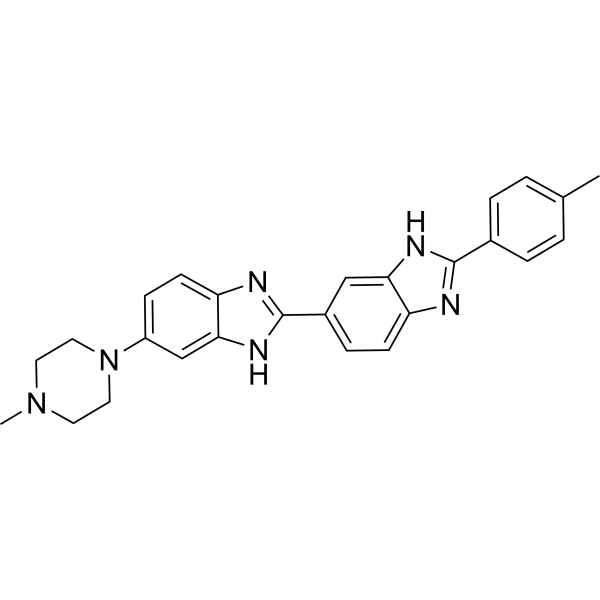
Hoechst 33258 analog 3
CAS No. 23554-98-5
Hoechst 33258 analog 3 ( —— )
产品货号. M27037 CAS No. 23554-98-5
Hoechst 33258 类似物 3 是用于 DNA 染色的蓝色荧光染料系列的一部分。
纯度: >98% (HPLC)
 COA
COA
 Datasheet
Datasheet
 HNMR
HNMR
 HPLC
HPLC
 MSDS
MSDS
 Handing Instructions
Handing Instructions
| 规格 | 价格/人民币 | 库存 | 数量 |
| 5MG | ¥2811 | 有现货 |


|
| 10MG | ¥4026 | 有现货 |


|
| 25MG | ¥6423 | 有现货 |


|
| 50MG | ¥9153 | 有现货 |


|
| 100MG | ¥12312 | 有现货 |


|
| 500MG | ¥24057 | 有现货 |


|
| 1G | 获取报价 | 有现货 |


|
生物学信息
-
产品名称Hoechst 33258 analog 3
-
注意事项本公司产品仅用于科研实验,不得用于人体或动物的临床与诊断
-
产品简述Hoechst 33258 类似物 3 是用于 DNA 染色的蓝色荧光染料系列的一部分。
-
产品描述Hoechst 33258 analog 3 is part of a family of blue fluorescent dyes used to stain DNA.(In Vitro):The dyes Hoechst 33258 and Hoechst 33342 are the ones most commonly used and they have similar excitation/emission spectra. Both dyes are excited by ultraviolet light at around 350 nm, and both emit blue/cyan fluorescent light around an emission maximum at 461 nm. Unbound dye has its maximum fluorescence emission in the 510-540 nm range. Hoechst dyes are soluble in water and in organic solvents such as dimethylformamide or dimethyl sulfoxide. Concentrations can be achieved of up to 10 mg/mL. Aqueous solutions are stable at 2-6 °C for at least six months when protected from light. For long-term storage, the solutions are instead frozen at ≤-20 °C. Although the dyes can bind to all nucleic acids, AT-rich double-stranded DNA strands enhance fluorescence considerably. Hoechst dyes are cell-permeable and can bind to DNA in live or fixed cells.
-
体外实验——
-
体内实验——
-
同义词——
-
通路Others
-
靶点Other Targets
-
受体antioxidant
-
研究领域——
-
适应症——
化学信息
-
CAS Number23554-98-5
-
分子量422.536
-
分子式C26H26N6
-
纯度>98% (HPLC)
-
溶解度In Vitro:?DMSO : 3.57 mg/mL (8.45 mM)
-
SMILESCN1CCN(CC1)c1ccc2nc([nH]c2c1)-c1ccc2nc([nH]c2c1)-c1ccc(C)cc1
-
化学全称——
运输与储存
-
储存条件(-20℃)
-
运输条件With Ice Pack
-
稳定性≥ 2 years
参考文献
1.Tania Kundu, et al. Expeditious and eco-friendly synthesis of new multifunctionalized pyrrole derivatives and evaluation of their antioxidant property. Bioorg Chem. 2020 May;98:103734.
产品手册




关联产品
-
Gastrin-Releasing Pe...
Gastrin-releasing peptide is a regulatory human peptide that elicits gastrin release and regulates gastric acid secretion and enteric motor function. The post-ganglionic fibers of the vagus nerve that innervate the G cells of the stomach release GRP, which stimulates the G cells to release gastrin.
-
Aschantin
Aschantin 是一种双环氧木脂素,可以从木兰中分离出来。Aschantin 具有抗疟原虫、Ca2+ 拮抗、血小板活化因子拮抗和化疗活性。 Aschantin 是一种 mTOR 激酶抑制剂。 Aschantin 也是细胞色素 P450 和 UGT 酶的抑制剂。
-
SGA360
SGA360 是一种选择性芳烃 (Ah) 受体调节剂。它具有抗炎特性。



 021-51111890
021-51111890 购物车()
购物车()
 sales@molnova.cn
sales@molnova.cn







